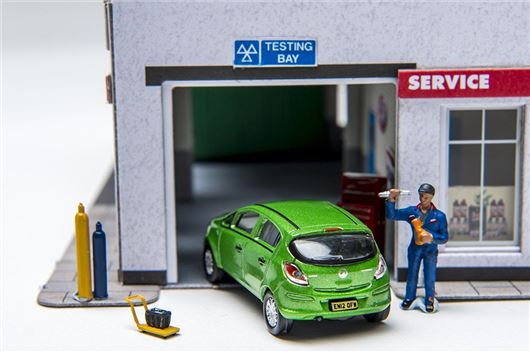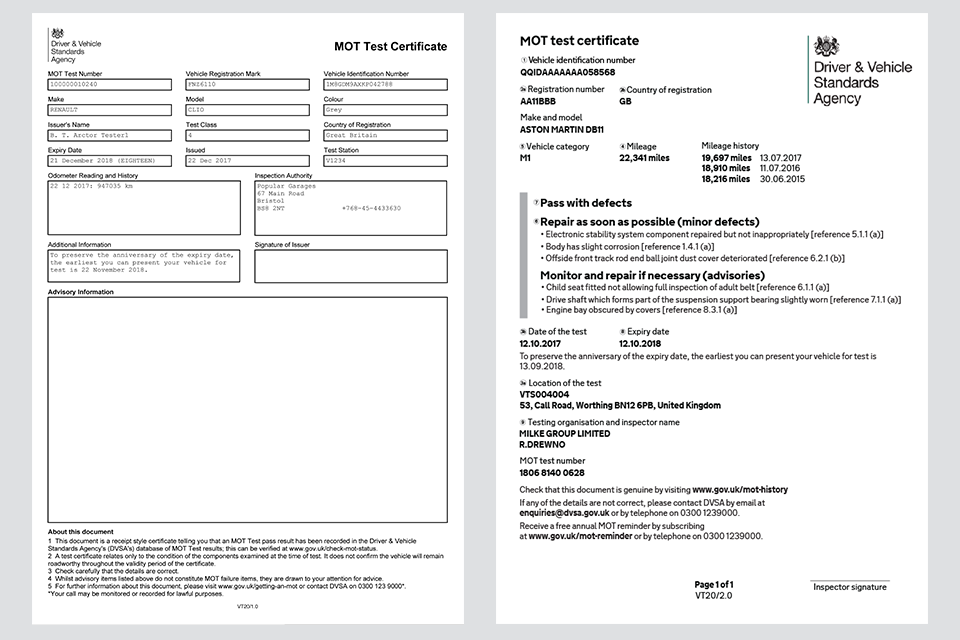Will your car fail the new MoT?

There's been a lot of confusion lately surrounding the incoming MoT changes, namely about whether older diesels are likely to pass. So we've broken it down into the five major changes you need to know about.
The MoT changes will affect diesel vehicles
Diesel cars with a Diesel Particulate Filter (DPF) will find it harder to pass the MoT from May 2018 when the Government introduces strict new rules on emissions.
From 20 May 2018, any Euro5 diesel that emits visible smoke of any colour will automatically fail the MoT. DPFs will also face mandatory checks, with failures being issued if the tester finds evidence that the filter was removed or has been tampered with.
According to the Driver and Vehicle Standards Agency (DVSA) guidance document 'an automatic failure will be issued if the DPF canister has been cut open and re-welded, unless the owner can provide documented evidence for a legitimate reason like a filter clean'.
>> Everything you need to know about DPFs
"The new system creates the potential for confusion as testers will have to make a judgement as to whether faults are Dangerous, Major or Minor."
New items will now be tested under the MoT
There are a few things that will be tested for the first time. These include if tyres are obviously under-inflated, if the brake fluid has been contaminated, fluid leaks posing an environmental risk, brake pad warning lights and if brake pads or discs are missing.
Reversing lights on vehicles first used from 1 September 2009 will also be part of the MoT for the first time and must operate automatically when reverse gear is selected. Aftermarket high intensity discharge (HID) headlamps will also be banned, with owners required to convert their HID headlamps back to halogen.
>> Top 10 causes of MoT test failures
Headlight washers on vehicles first used from 1 September 2009 (if they have them) and daytime running lights on vehicles first used from 1 March 2018 (most of these vehicles will have their first MoT in 2021) will also be checked.
Defects will be categorised differently
The DVSA is introducing new defect categories, with test faults now being listed as Minor, Major or Dangerous. Any car that gets a Dangerous fault will fail and be deemed illegal to be driven on the road.
A Major fault will also fail and be subject to a repair and retest. Minor defects will be considered along the same lines as advisories, allowing the vehicle to pass with the faults being noted to the MoT history. The MOT tester gives each item a category depending on the type of problem and seriousness.
However, RAC spokesman Simon Williams said: "The new system creates the potential for confusion as testers will have to make a judgement as to whether faults are Dangerous, Major or Minor. This will surely be open to interpretation which may lead to greater inconsistency from one test centre to another."
| Category | What it means | How it affects the MoT result |
| Dangerous | A direct and immediate risk to road safety or has a serious impact on the environment. Do not drive the vehicle until it’s been repaired. | Fail |
| Major | It may affect the vehicle’s safety, put other road users at risk or have an impact on the environment. Repair it immediately. | Fail |
| Minor | No significant effect on the safety of the vehicle or impact on the environment. Repair as soon as possible. | Pass |
| Advisory | It could become more serious in the future. Monitor and repair it if necessary. | Pass |
| Pass | It meets the minimum legal standard. Make sure it continues to meet the standard. | Pass |
Some vehicles over 40 years old won’t need an MOT
Cars, vans, motorcycles and other light passenger vehicles won't need to have an MoT if they're over 40 years old. At the moment, only vehicles first built before 1960 are exempt from needing an MoT.
That means any car built before 1 January 1978 is included. If you already own a 1977 car, you'll need to contact DVLA to change its VED class to 'historic' to take advantage of the tax break.
You won't have to apply to stop getting an MoT for your vehicle, however, each time you tax your historic vehicle (even if you don’t pay a fee), you'll have to declare it meets the rules for not needing an MoT.
The MoT ceritificate will change
The design of the MoT certificate will, after 20 May 2018, list any defects under the new categories, so they're clear and easy to understand.

The DVSA has also scrapped plans to extend the first MoT for new cars from three to four years. A Department for Transport (DfT) consultation in 2017 considered changing the period before the first test to four years, a move that was met with significant concern by HonestJohn.co.uk.

 Georgia Petrie
Georgia Petrie
 Two thirds back mandatory driver retests for older drivers
Two thirds back mandatory driver retests for older drivers
 BYD Atto 2 2025: Prices, specs and release date
BYD Atto 2 2025: Prices, specs and release date
 Question of the week: Is age or mileage more important on a used car?
Question of the week: Is age or mileage more important on a used car?
 A future classic? Chrysler PT Cruiser
A future classic? Chrysler PT Cruiser
 Volkswagen Transporter 2025: Prices, specs and release date
Volkswagen Transporter 2025: Prices, specs and release date
 Dicing with death: Gen Z are refusing to buckle up
Dicing with death: Gen Z are refusing to buckle up
 Toyota Urban Cruiser 2025: Prices, specs and release date
Toyota Urban Cruiser 2025: Prices, specs and release date





.jpg)






Jas1 on 20 May 2018
I have a 2011 registered Focus MK2.5 Titanium which I purchased on its third birthday back in 2014. I then converted the front fog lamps to DRL'S using 2 x H11 Cree 7 watt LED lamps and a DRL wiring harness.The DRL's automatically come on when the ignition is switched on and automatically go off when the side / headlamps switch is activated. Not as is the case of the front fog lamps which are controlled via the front fog lamp switch on the dash.Whilst the latter switch is still physically there as is the wiring harness, it is not connected to any lamps.
Now on the MK2 Focus I had owned for five years before that purchase, I only used the fogs twice for circa two hours in total.
So will the new MOT rules force me to go back to a less visible on road vehicle, with a nigh on redundant set of lamps on the front of it ?
Regards,
JAS
mishmos on 21 May 2018
Brilliant. About time that the MOT was updated. Maybe we will see some of the rotten junkers and polluters taken off of the road. If you have a car that is well maintained and is one of the lesser polluting evils what's the problem.
Edited by Avant on 26/05/2018 at 18:35
Classical on 21 May 2018
Edited by Classical on 21/05/2018 at 18:01
flying_porker on 21 May 2018
I am flabbergasted that missing brake pads would not have been failed before. For many years my cars were heaps of junk, but at least they could stop, even if they didn't go very well.Murray Snudge on 21 May 2018
Perhaps it would have failed the brake test but not because the pads or discs/drums were missing?
Remember that it is highly trained and qualified civil servants who write the legislation so who are we to criticise? :-)
Murray Snudge on 21 May 2018
I drive a 1991 Ford Escort diesel and will continue to do so.Murray Snudge on 21 May 2018
Just what do you think it will fail on just out of interest?
WestfieldLad on 21 May 2018
Scraped?
mishmos on 21 May 2018
I've been driving for over 40 years and reckon I have used my fog lights no more than 20 times living and working in 5 countries across Europe.
What part of the foggy world are you living in?
Maxonian on 21 May 2018
Foggy Manchester. Use them in mist and heavy rain too. But not that often.I love the guys who have them on in this bright sunlight weather but in dusk in winter have no lights on at all.
Zapdog on 1 June 2018
Like the 40yr driver above - I think I've only used mine around 20 or so times in my life time.
I was interested why you use them in mist and heavy rain. Possibly the two worst scenarios. Is it because you want to blind your fellow drivers who, because of your stupidness, cannot see your break lights or just plain annoy them.
Please reveal what logical reason. Nonethless, you definitely need to read the Highway Code.
The police need to pull fools like you over and fine them........
Maxonian on 21 May 2018
I followed a taxi last week spewing grey smoke. Tell me, how do they get away with it?retired surveyor on 21 May 2018
No doubt cars that have done lots of miles will have job passing. Cars that are not maintained too, but what about all the smoking lorrys, buses, not to say anything about the trains.Murray Snudge on 21 May 2018
It's only cars that have a DPF that will fail if they emit any smoke. Obviously they still have to pass the emissions test that is relevant to the particular vehicle.
My old Escort diesel has gone straight through the 'fast pass' for the last few years but doesn't need to be Euro 5 compliant so doesn't have a DPF
NickNike on 25 May 2018
So your car pumps carbon particulates into the air we breathe?
Nigel P on 21 May 2018
I daily follow many cars and small commercial vans that pour out smoke, it's getting so bad now I have never used my in car recirculate button so much to stop the fumes coming in the car and know this itself comes with an alleged risk also. Will this new MOT make a difference and get these vehicles fixed or off the road - I hope so.Classical on 21 May 2018
Why faff around with all that nonsense JAS? Why not just use dipped headlamps at all times? I do, year round and it means my rear lights on too! (Immaculate 1995 Mondeo)
Classical on 21 May 2018
Why faff around with all that nonsense JAS? Why not just use dipped headlamps at all times? I do and have the benefit of rear lights on too! (Immaculate 1995 Mondeo)
on 21 May 2018
All very understandable, but I know there are lots of dodgy mates rates Mot places about.My mate said when he took his old diesel focus in they didn't even check the emission's.!!
Mgarth on 21 May 2018
Why is everything changing all of a sudden with all the rules and regulations with Dvlapaul jenkins on 22 May 2018
well done tory voters idiotsJas1 on 22 May 2018
faff ..nonsense er
They are DRL's conforming to DRL fitting and switching rules.
Fitted them in one hour,
DRL wiring harness £13.91
2 x H11 Cree 7 watt LED lamps £12.98
Your preferred option 2 x 55 watt 2 x 5 watt = 120watt, I'm pulling 14 watt..
I've also installed front and rear dash cams wired via the ignition. Be interested to know your views on those as well.
Edited by Jas1 on 22/05/2018 at 22:40
Add a comment